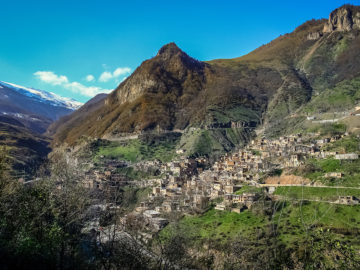Gilan province, with an area of 14042 km, is located in the northwest of Iran and on the southwest coast of the Caspian Sea, neighboring the provinces of Ardabil, Zanjan, Qazvin, and Mazandaran. It is the 28th biggest province in the country in terms of area. The Astara-Chai River is the border between the province and the Republic of Azerbaijan.
This province has 16 counties including Rasht city as its center. Most of the people in the province are Gilak and speak Gilaki with different dialects, while in some parts of the province people also speak Farsi. Gilan province has the heaviest amount of rainfall in the country due to its proximity to the Caspian Sea, causing its weather to be moderate and humid.
Greek historians have referred to Gilan as Kados and Kadosyan. During the Achaemenid (550-330 B.C.) and Sassanid (224-651 A.D.) Empires, independent local governments ruled continuously in this area. The impassibility of the region made limited the accessibility of the Islamic army that invaded Iran at the end of the Sassanid Empire but Islam faith was gradually scattered throughout Tabarestan and Mazandaran regions in the province by the Shiites of the Zaidiyyah sect during the eighth century.
Later, during the Mongol (1206-1368) and Karkiya (1370-1592) dynasties, this region was captured but when Abbas I during the Safavid Dynasty (1501-1736) attacked there and conquered it, Gilan lost its independence and officially became a part of Iran.
The land of Gilan was in the past divided into the three districts of Talesh, Deylam, and Gilan (Jilan) but when captured by Safavids, its center was transferred to Rasht. Based on the Treaty of Golestan, a part of Talesh in the north of Astara River was separated from the land of Iran. During the constitutional movement, Aqabaala Khan, the ruler of Gilan, was killed in the garden of Modiriyeh, Rasht and the area’s constitutionalists moved to conquest the capital Tehran city. They first captured Qazvin and then after three days, along with Bakhtiari constitutionalists conquered the capital and Mohammad Ali Shah was dethroned from the monarchy.
The beautiful nature of Gilan province and the Caspian shores are among the most important attractions in this area, attracting a huge number of nature lovers throughout the year. Of the spectacular natures of the province include the dense forests in the northern slopes of Alborz especially in the south of Sinalak city and Deilman forests, south of Lahijan, and the areas around Shafte, Fouman, Masal, Talesh, Rezvanshahr, and Astara cities. The Lahijan tea fields, Masouleh village, Rudkhan Castle in Fuman, Tomb of Mirza Kuchak Khan, and Herzwil’s millennia-old cypress are among the cultural and historical attractions of the province.
The area also benefits from various handicrafts including mat weaving, woodcraft, shawls, bamboo, pottery, Jajim, carpet, Kilim, Chador-Shab, crocheting, felt, and Charooq. In terms of cuisine, a variety of cookies, especially Lahijan and Fouman’s ones, jam, pickles, tomato paste, olive, fish, rice, citrus, herbs, caviar, and Reshteh khoshkar could be found as the souvenirs of a trip to Gilan.
Rasht city was registered in December 2005 as the creative city in gastronomy by UNESCO and joined the Creative Cities Network.
Finally, Fazlollah Reza, Anoushirvan Rouhani, Mohammad Moein, and Mohammad Shams Langeroodi are among the celebrities of Gilan.

